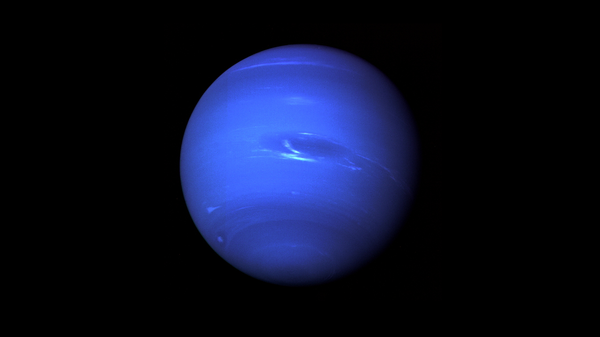NASA’s Jet Propulsion Laboratory (JPL) recently completed a study of two of Neptune’s moons, Thalassa and Naiad, which perform what the scientists called a “dance of avoidance” as they orbit the ice giant. The two small moons orbit Neptune very close to one another, but always avoid hitting each other because they keep their distance, following a perfect pattern on a slight tilt from each other.
"We refer to this repeating pattern as a resonance," Marina Brozović, an expert in solar system dynamics at the JPL and the lead author of the paper, said in a NASA press statement. "There are many different types of 'dances' that planets, moons and asteroids can follow, but this one has never been seen before."
The paper was published in Icarus, but is also available online at arXiv.
The two Tic Tac-shaped moons are only about 60 miles across, with orbital paths only about 1,150 miles apart and with Thalassa taking about half an hour longer to complete an orbit than Naiad. However, because of their resonance pattern, every time Naiad passes through Thalassa’s orbital plane, the two moons are about 2,200 miles apart.
"We suspect that Naiad was kicked into its tilted orbit by an earlier interaction with one of Neptune's other inner moons," Brozović said. "Only later, after its orbital tilt was established, could Naiad settle into this unusual resonance with Thalassa."
The study also revealed the moons are likely mostly made of ice and not rock, similarly to the dim rings around Neptune and other gas giants like Saturn.
"We are always excited to find these co-dependencies between moons," Mark Showalter, a planetary astronomer at the SETI Institute in Mountain View, California, and a co-author of the paper, said in the press release. "Naiad and Thalassa have probably been locked together in this configuration for a very long time, because it makes their orbits more stable. They maintain the peace by never getting too close."
Resonances have been found among other moons of the giant outer planets, which because of their great size and powerful gravity have attracted dozens of moons. Neptune has 14 satellites; most are small, but one, Triton, is larger than the dwarf planet Pluto and is one of the few geologically active objects in the solar system.
A 2015 video produced by the JPL showed the Neptunian system under the watchful eye of the Kepler telescope, a space probe typically used to identify extrasolar planets.
Back in August, NASA commemorated the 30th anniversary of the Voyager 2 probe’s close pass by Neptune in 1989. Voyager 2 was the only human-made object to pass through the outer solar system, and captured the first and only up-close photographs of the deep blue ice giant and of Triton. It took the spacecraft 12 years to reach Neptune.

